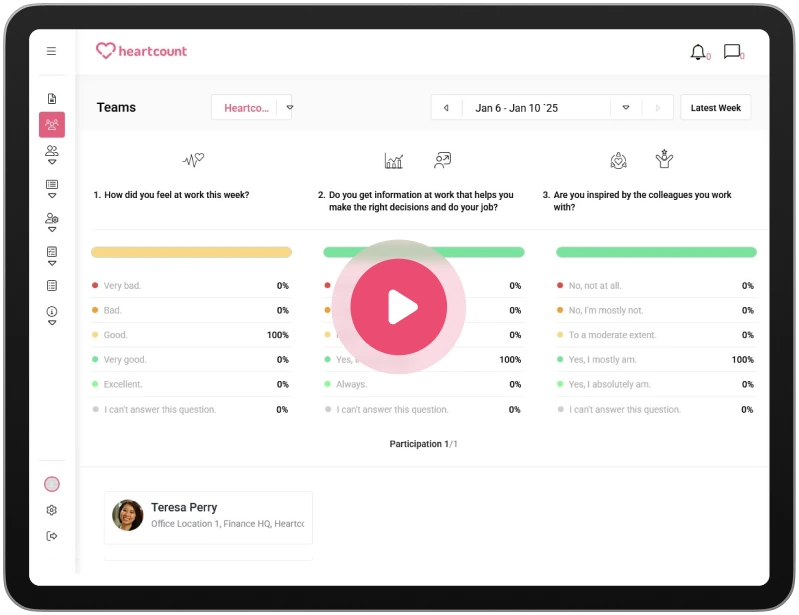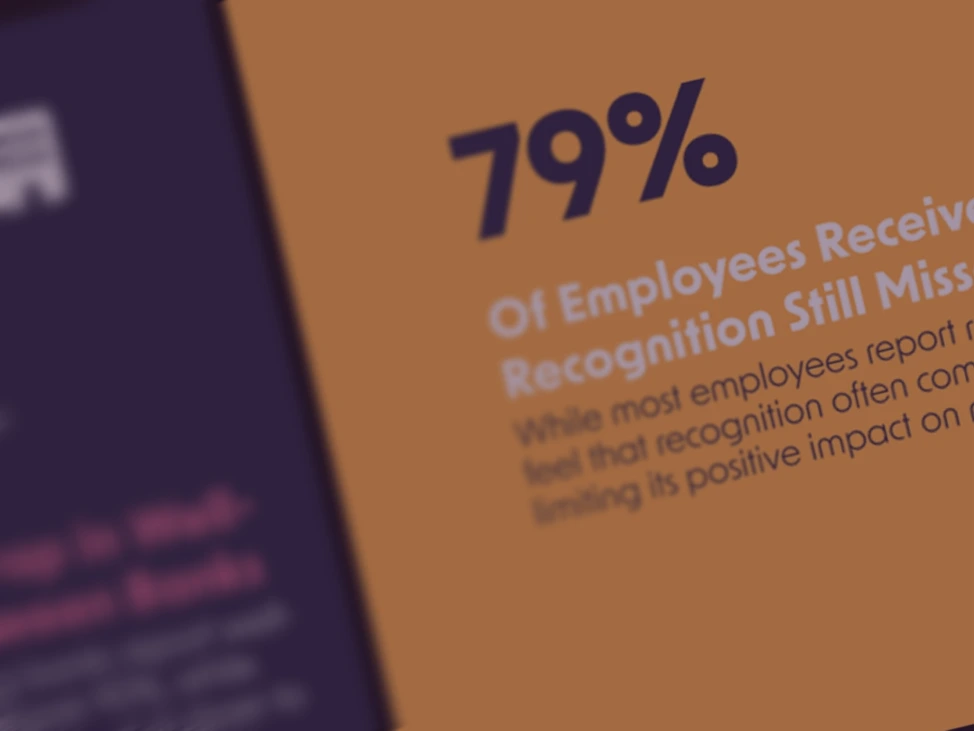How to increase employee engagement survey participation?

Understanding your employees is vital for any business to succeed. However, gathering employee data is different in a 10-person startup than in a 500+ employee organization.
For the latter, you should opt-in for regular employee surveys to understand your employees better. The trick, however, is that not all employees will think it’s important enough to participate. That’s a problem because if there are not enough participants, you can’t really call a survey “successful.”
So, if you’re finding that the attendance rate is low, here’s how to increase employee engagement survey participation that will help you get crucial data for your business.
-
1.Why is employee engagement important?
-
2.Participation rate vs. response rate in pulse survey
-
3.Why employees don’t participate in surveys?
-
4.Benefits and drawbacks of a low participation rate
-
5.Tips on how to increase employee engagement survey participation
-
6.More employee survey participation = more useful survey data
Understanding your employees is vital for any business to succeed. However, gathering employee data is different in a 10-person startup than in a 500+ employee organization.
For the latter, you should opt-in for regular employee surveys to understand your employees better. The trick, however, is that not all employees will think it’s important enough to participate. That’s a problem because if there are not enough participants, you can’t really call a survey “successful.”
So, if you’re finding that the attendance rate is low, here’s how to increase employee engagement survey participation that will help you get crucial data for your business.
Why is employee engagement important?
Employee engagement represents employees’ enthusiasm and emotional investment in the organization and its success. Engaged employees aren’t “just there;” instead, they’re more than spectators—they actively participate in the company’s goals. In other words, they are motivated to help the company succeed and enthusiastic about their work.
Engaged employees are typically:
- More loyal to the company and therefore stay longer. They have a sense of belonging and won’t seek the first opportunity to switch.
- Work harder, but in a smart way. Engaged employees like to take initiative and not wait for someone above to give them directives. They reject the” status quo” and are constantly looking to improve.
- Become an inspiration for others by fostering collaboration, communication, and an overall positive work environment. Engaged employees tend to report higher job satisfaction. This, in turn, makes them more likely to support others and create an atmosphere of open communication and trust.
Participation rate vs. response rate in pulse survey
Participation rate is the percentage of employees who take part (participate) in a survey. For instance, if you invite 100 employees to a survey and 80 complete it, that survey will have a participation rate of 80%.
On the other hand, a response rate refers to the percentage of employees who have answered (responded) to particular survey questions or parts. For example, if 56 employees responded to a question out of 80 who participated in a survey, the response rate for that question is 70%.
Why are these important?
First, if the employee participation rate is low, your data will be skewed, probably leading to wrong conclusions. This is why a high participation rate is crucial for the survey to represent the organization accurately. On top of that, a low participation rate is likely a sign of distrust and disengagement among employees, while a high participation reflects the employees’ willingness to share their thoughts.
However, participation is not enough. You need employees to answer specific questions. Otherwise, your gathered data will be incomplete, and you may miss out on critical data regarding specific issues and trends.
COLLECT
Why employees don’t participate in surveys?
Employees don’t participate in surveys for different reasons. For instance, the survey may not be relevant to them, they may lack faith in management’s ability to act on it, or they may worry that the survey will not be anonymous.
Through extensive talk with all our clients and business partners, we were able to detect seven main points you should investigate if you’re employees are not keen to participate in surveys:
- Poor timing. Peak business periods, like the holiday season or the end of the year, are not the best times to ask employees to participate in a survey, as they are too busy (and likely a little stressed). Their answers may be emotionally colored by what’s happening at the precise moment, and they may overlook the rest of the year.
- Lack of faith in the management and leadership. If the employees lack faith in their leadership and their interest in their opinions, they may see the survey as pointless. Investigating employee relations more may be highly beneficial in understanding where the trust-breaking patterns come from.
- No clear message. A lack of clear understanding of why surveys are there in the first place, how they will be conducted, and what will be done with employees’ answers could cause the spreading of false information and increase gossiping and other toxic behaviors. In the end, it could produce groundless fear of surveys and what they represent and cause a low participation rate,
- The survey is too long or complex. Employees might not have the time for lengthy and complex traditional employee surveys with 100+ questions. They often get bored and overwhelmed and develop negative sentiments towards obligatory surveys.
- Lack of anonymity. Employees are often less open to communicating their feelings and opinions about the company and leadership if you can’t guarantee their anonymity in a survey. This is one of the keys to collecting honest feedback and increasing participation rates in workplaces that lack transparency in communication and decision-making.
- No or unclear incentives. What is the employees’ motivation for participating in the survey? Without it, employees won’t feel as inclined to complete the survey. This can be as simple as a participation badge or the employees understanding that they made a positive impact by participating.
- Lack of actionable feedback. Surveys should lead to meaningful changes in the company. For that to be the case, HR and management must be ready to address the information they get through it clearly and transparently and provide actionable feedback on the survey.
Benefits and drawbacks of a low participation rate
Generally, a low employee survey participation rate tells us something went south… Probably a long time ago. It’s a warning sign you’re headed to low employee sentiment and disengagement.
However, the positive side of having a low participation rate exists, as it helps you highlight opportunities for improvement and optimization. More on what to do about it will be discussed later in the article.
The downsides of low participation rates in employee engagement surveys are not negligible. These are just some of the reasons you should pay attention to it.
- Skewed results: Since the low participation rate doesn’t adequately represent the views of the majority of the workforce, the data will be incomplete and lead to wrong decision-making.
- Negative culture reinforcement: Low participation leads to inaction, which creates disengagement, which leads back to low participation.If the organization already has a negative culture, a low survey participation rate will only confirm to employees that their feedback doesn’t matter. It’s a cycle.
- Wasted resources: Surveys take time and cost money. You need to design, distribute, and eventually analyze them. A low-participation survey has a low return on investment, as the insight and data might not be relevant enough.
- Hard to detect trends: Certain trends can only be seen if the participation rate is high. However, if it’s low, it becomes difficult to identify trends and patterns in your company.
Tips on how to increase employee engagement survey participation
Explain the survey’s purpose
Conducting an employee survey just for the sake of performing it is never a good idea, and you should not expect it to lead to any positive results. Instead, convey the survey’s purpose to your employees before asking them to complete it.
Surveys can have different purposes, from measuring job satisfaction, assessing employee engagement, or gathering feedback on company culture. Carefully define why you’re doing the survey and explain its purpose to employees.
For example, Google performs an annual ” Googlegeist ” survey to assess employee morale and job satisfaction levels and gather feedback on career development opportunities, leadership, company culture, compensation, etc.
This has helped Google, for instance, discover that in 2022, only 46% of its employees (who responded to the survey) were satisfied with their compensation compared to similar roles in other companies.
Simplify the survey process
Traditional employee surveys can easily overwhelm employees with too many questions, and they’re conducted too rarely. Instead, focus on weekly pulse surveys with 3-5 questions and specific topics. These will provide quick insight, making employees feel safe and more likely to participate.
Also, offers the option to complete a survey on mobile and tablet devices so employees can respond to them on the go. The more options you give, the more responses you will get.
For example, with HeartCount, you can automate weekly pulse check surveys. Employees’ll take only 2-3 minutes to complete, and you’ll have insights into your team’s wellbeing within a business day.

Guarantee confidentiality to build trust
One of the biggest reasons employees are unwilling to participate in surveys is the fear of reprisal for giving negative feedback. In the U.S., 34% of employees do not speak up due to fear of retaliation by the employer. Alleviate those fears by ensuring that the survey will be completely anonymous and that their manager or leaders won’t know who sent it.
One such example of an anonymous employee survey that encourages honest feedback is Microsoft’s “Employee Signals” survey. Thanks to this survey, the company has improved employee experience by actively listening to them. The company did this by analyzing data from multiple feedback sources and identifying critical issues. This allowed Microsoft to address systemic challenges that affected employee satisfaction and productivity.
Send out reminders and follow-ups
Always remember your employees are probably busy enough with their daily tasks that they simply don’t have the time to complete the surveys you send them on time.
Send them a nudge on the communication channel your company is using (Slack, Microsoft Teams) or a friendly reminder over email. Be sure to highlight the deadline and explain the survey’s purpose again.
As mentioned, with HeartCount, employee surveys are fully automated, ensuring that your team receives surveys always at the same time. Additionally, HeartCount includes automated reminders. If employees don’t respond, they’ll receive email notifications about the missed survey, which improves the participation rate.

Outline how feedback will be reviewed and acted upon
Communicate how the feedback review process will be implemented to ensure employees want to participate.
Start by explaining how the feedback will be collected and analyzed, ensuring that employees know that it will be anonymous. Next, define the action plan. For instance, “management will prioritize actions based on common feedback points.”. Finally, clear and realistic expectations should be set (30 days after survey results).
Show employees that their feedback is valued and leads to real changes
Finally, don’t disappoint employees by showing them their feedback doesn’t lead to any real changes. Show them you genuinely care about their opinion and act upon it.
UNDERSTAND
More employee survey participation = more useful survey data
Surveys are ideal for understanding employees’ sentiments about management and the company. However, without enough employees participating, you can’t draw meaningful conclusions from them.
It’s essential first to understand why your employees don’t take part in your surveys and then see what tactics and best practices you can incorporate to increase their participation.
Follow this helpful guide to increase employee engagement survey participation to ensure your surveys are effective.
Ready to increase employee engagement survey participation in your organization? HeartCount can help you make it happen.









